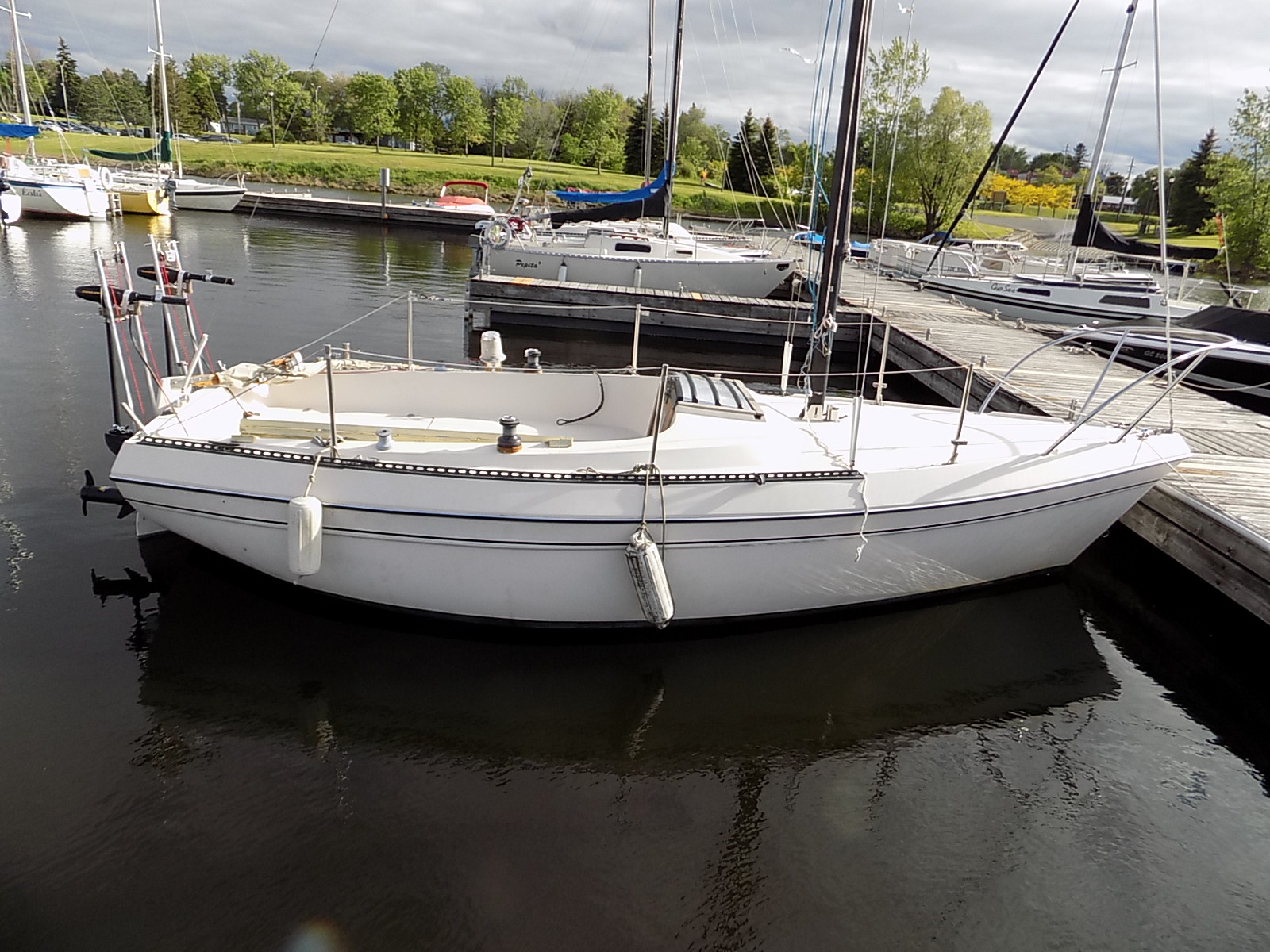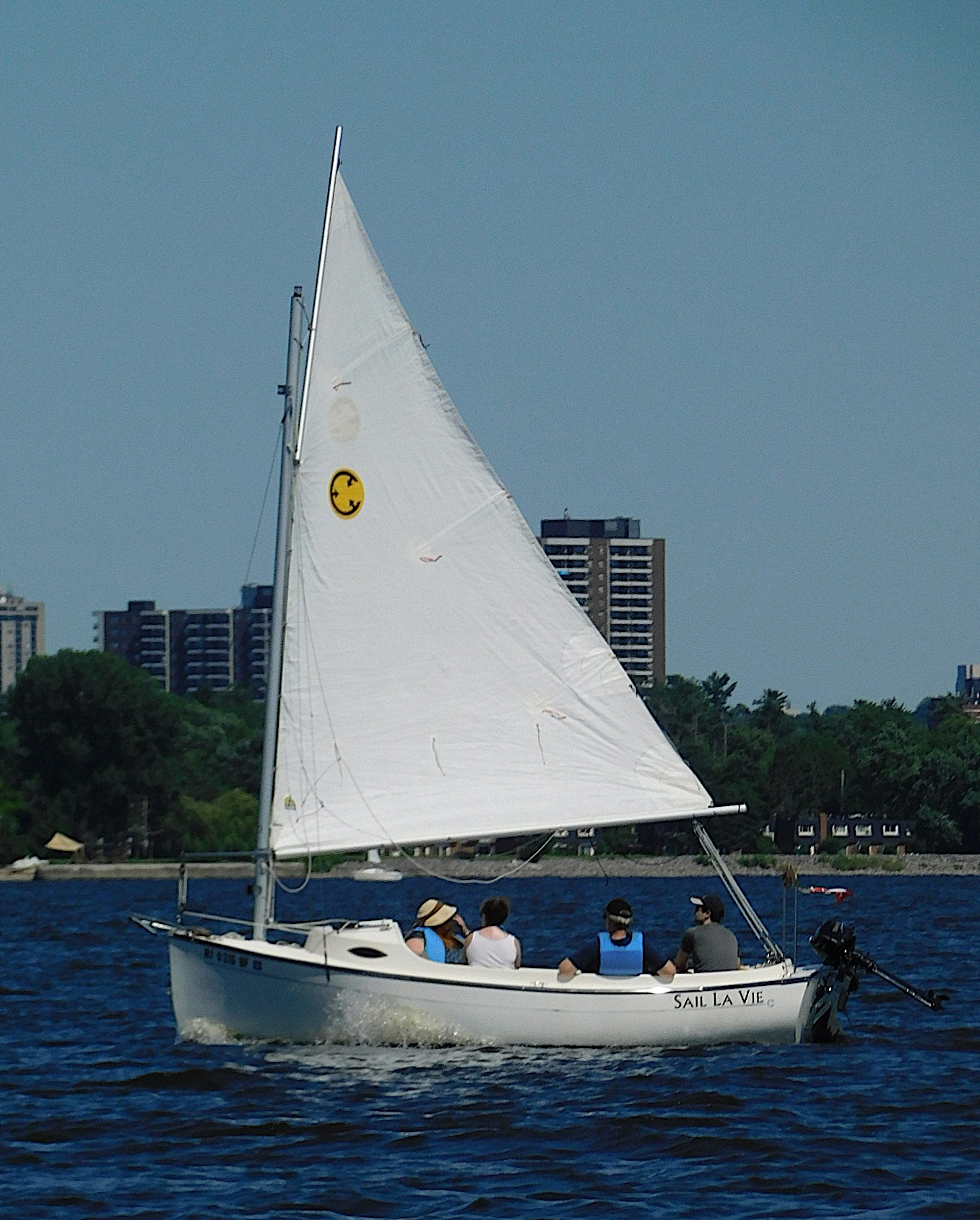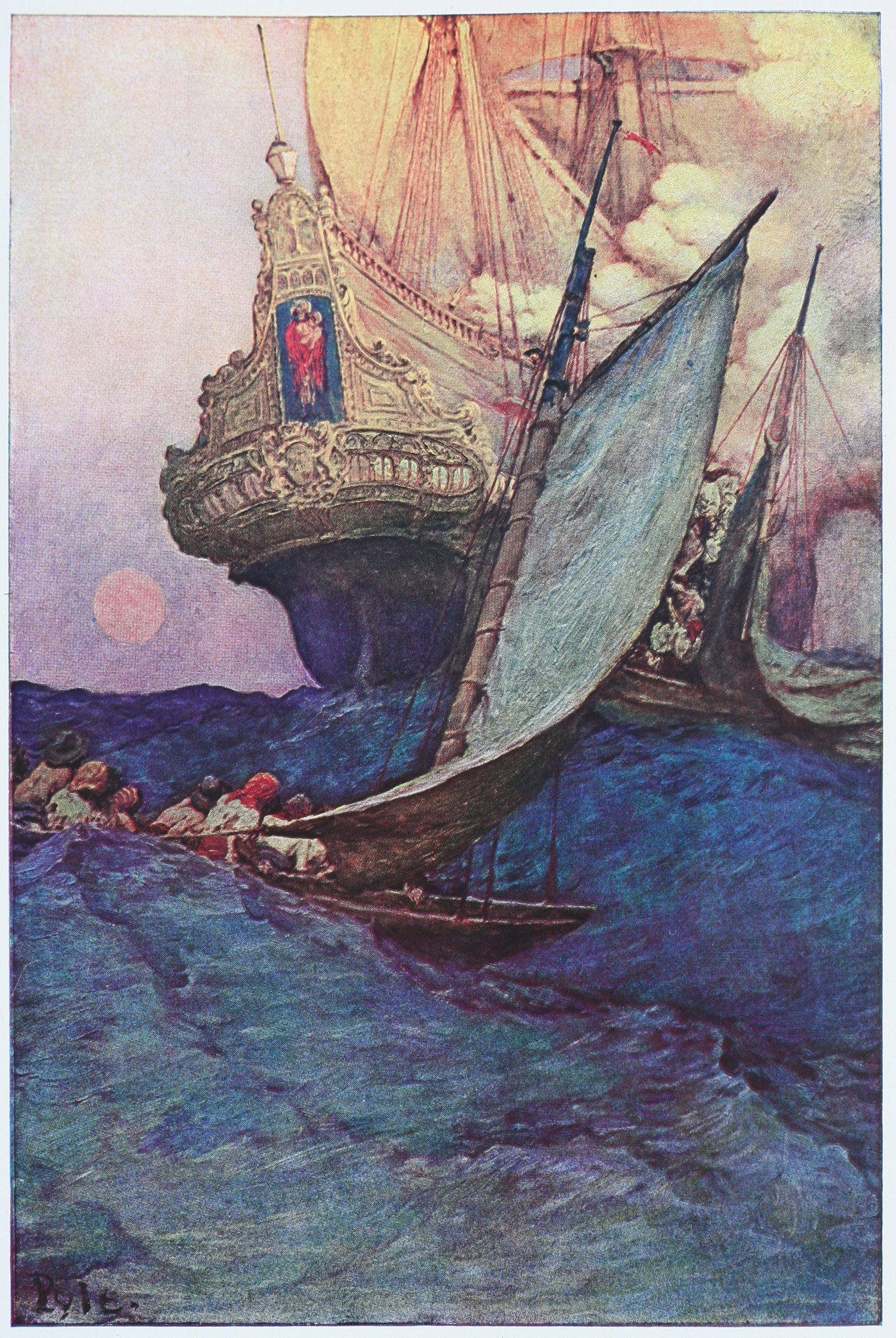|
Buccaneer 200
The Buccaneer 200 is an American trailerable sailboat, that was designed by Alan Payne and first built in 1974. The Buccaneer 200 is a development of the Columbia T-23 design, using the same tooling to build the hull. Production The boat was built by Bayliner Marine Corporation in the United States starting in 1974, but it is now out of production. Design The Buccaneer 200 is a small recreational keelboat, built predominantly of fiberglass, with wood trim. It has a masthead sloop rig, a transom-hung rudder and a fixed long shoal-draft keel. It displaces and carries of ballast.Henkel, Steve: ''The Sailor's Book of Small Cruising Sailboats'', page 87. International Marine/McGraw-Hill, 2010. The boat has a draft of with the standard keel, allowing beaching or ground transportation on a trailer. It is normally fitted with a small outboard motor for docking and maneuvering. The cabin is small but includes a double berth, a quarter berth, galley with a sink and a fold down ... [...More Info...] [...Related Items...] OR: [Wikipedia] [Google] [Baidu] |
Alan Payne (naval Architect)
Alan Newbury Payne Order of Australia, AM (11 December 1921, London – 20 June 1995, Sydney) was a naval architectAlan Payne Australian National Maritime Museum, accessed 26 December 2013 born in England but who worked in Australia. His yacht designs were readily built by both professionals and amateurs, and remain well represented in the ocean-going and coastal yacht fleet.Used Alan Payne boats for sale boatsales.com.au, accessed 27 December 2013 Youth Payne was born in London, England in 1921, but moved as part of his family ...[...More Info...] [...Related Items...] OR: [Wikipedia] [Google] [Baidu] |
International Marine
S&P Global Inc. (prior to April 2016 McGraw Hill Financial, Inc., and prior to 2013 The McGraw–Hill Companies, Inc.) is an American publicly traded corporation headquartered in Manhattan, New York City. Its primary areas of business are financial information and analytics. It is the parent company of S&P Global Ratings, S&P Global Market Intelligence, S&P Global Mobility, S&P Global Engineering Solutions, S&P Global Sustainable1, and S&P Global Commodity Insights, CRISIL, and is the majority owner of the S&P Dow Jones Indices joint venture. "S&P" is a shortening of "Standard and Poor's". Corporate history The predecessor companies of S&P Global have history dating to 1888, when James H. McGraw purchased the ''American Journal of Railway Appliances''. He continued to add further publications, eventually establishing The ''McGraw Publishing Company'' in 1899. John A. Hill had also produced several technical and trade publications and in 1902 formed his own business, The ''Hill ... [...More Info...] [...Related Items...] OR: [Wikipedia] [Google] [Baidu] |
Drascombe Scaffie
The Drascombe Scaffie, now marketed as the Devon Scaffie, is a British trailerable sailboat that was designed by John L. Watkinson and first built in 1978. The modern Scaffie is based upon a traditional British boat design that dates back several hundred years.Sherwood, Richard M.: ''A Field Guide to Sailboats of North America, Second Edition'', pages 48-49. Houghton Mifflin Company, 1994. The Scaffie design is one of a large range of similar Drascombe boats with different hull, cabin and rig configurations. Production The design has been built by Honnor Marine Classics in Swanage, Dorset, United Kingdom. It remains in production. Design The Scaffie is a recreational sailboat, built predominantly of fibreglass, with hardwood trim. It is an open boat, with no cabin. It has a lug sail rig with Sitka spruce spars and a loose-footed, terylene mainsail. A sloop rig is a factory option. The lapstrake-style hull has a spooned raked stem, a rounded transom, a transom-hung, wooden ... [...More Info...] [...Related Items...] OR: [Wikipedia] [Google] [Baidu] |
Drascombe Lugger
The Drascombe Lugger is a British trailerable sailboat that was designed by John L. Watkinson and first built in 1968. The Drascombe Lugger design is the basis of a large range of similar Drascombe boats with different hull, cabin and rig configurations. Production The design is built by Honnor Marine Classics and also by Churchouse Boats, now called Drascombe Boats in the United Kingdom. Production started in 1968, with more than 2,000 boats completed and the design remains in production. Design The boat was designed by Watkinson, who was a former Royal Navy officer. In the early 1960s he wanted to build a small boat for his own family use. His design goals were for a day sailer with trailerability, that would be stable and safe, but still exciting to sail for experienced sailors. The prototype was built of wood on a farm in Drascombe Barton. The design was based upon the fishing boats used on England's northeastern coast, which trace their lineage back to the Vikin ... [...More Info...] [...Related Items...] OR: [Wikipedia] [Google] [Baidu] |
Chrysler 20
The Chrysler 20 is an American trailerable sailboat that was designed by Halsey Herreshoff and first built in 1977.Henkel, Steve: ''The Sailor's Book of Small Cruising Sailboats'', page 91. International Marine/McGraw-Hill, 2010. Production The design was built by Chrysler Marine in Plano, Texas, United States, from 1977 to 1980, but it is now out of production. Design The Chrysler 20 is a recreational keelboat, built predominantly of fiberglass, with wood trim. It has a masthead sloop rig; a raked stem; a nearly-plum transom; an internally mounted, swing-up, spade-type rudder controlled by a tiller and a stub keel with a swing keel. It displaces and carries of ballast. The boat has a draft of with the swing keel extended and with it retracted, allowing ground transportation on a trailer. The boat is normally fitted with a small outboard motor for docking and maneuvering. The design has sleeping accommodation for four people, with a double "V"-berth in the bow cabin ... [...More Info...] [...Related Items...] OR: [Wikipedia] [Google] [Baidu] |
Com-Pac Sunday Cat
The Com-Pac Sunday Cat is an American trailerable sailboat that was designed by Clark Mills, who had previously designed the Optimist. The Sunday Cat is a development of the Com-Pac Sun Cat. The Sun Cat comes in both cabin and open day sailer models. The Sunday Cat retains the large cockpit of the day sailer, but employs a small cuddy cabin that can accommodate a portable head. Production The design has been built by Com-Pac Yachts in the United States starting in about 2008 and remained in production in 2019. Design The Sunday Cat is a recreational keelboat, built predominantly of fiberglass. It has a cat rig with a single gaff-rigged sail, a plumb stem, a nearly vertical transom, a transom-hung rudder controlled by a wooden tiller and a stub keel, with a retractable stainless steel centerboard. It displaces and carries of fixed ballast. The boat has a draft of with the centreboard extended and with it retracted, allowing beaching or ground transportation on a ... [...More Info...] [...Related Items...] OR: [Wikipedia] [Google] [Baidu] |
Cal 20
The Cal 20 is an American sailboat, that was designed by C. William Lapworth and first built in 1961. Production The boat was built by Cal Yachts in the United States from 1961 to 1975, but it is now out of production. The Cal 20 was seen by Canadian Al Nairne during a visit to California. Nairne convinced Jack Jensen of Jensen Marine to allow him to produce the Cal 20 under licence in Canada and formed Calgan Marine in North Vancouver for that purpose. Calgan Marine went on to produce many Cal Yachts designs, plus designs of its own. A total of 1,945 Cal 20s were built during its 14-year production run. Design The Cal 20 is a small recreational keelboat, built predominantly of fiberglass. It has a fractional sloop rig, a transom-hung rudder and a fixed fin keel with a weighted bulb. It displaces and carries of ballast. The boat has a draft of with the standard keel fitted and is normally fitted with a small outboard motor for docking and maneuvering. The boat has a ... [...More Info...] [...Related Items...] OR: [Wikipedia] [Google] [Baidu] |
Buccaneer 210
The Buccaneer 210 is an American trailerable sailboat that was designed by Alan Payne as a cruiser and first built in 1974.Henkel, Steve: ''The Sailor's Book of Small Cruising Sailboats'', page 88. International Marine/McGraw-Hill, 2010. The boat is a development of the Columbia T-23, using the same hull molds. Production The design was built by Bayliner Marine Corp. in the United States, starting in 1974, but it is now out of production. Design The Buccaneer 210 is a recreational keelboat, built predominantly of fiberglass, with wood trim. It has a masthead sloop rig, a raked stem, a plumb transom, a transom-hung rudder controlled by a tiller and a fixed, very shallow draft, long keel. It displaces , carries of ballast and has positive foam flotation. The boat has a draft of with the standard keel. The boat is normally fitted with a small outboard motor for docking and maneuvering. The design has sleeping accommodation for six people, with a double "V"-berth in t ... [...More Info...] [...Related Items...] OR: [Wikipedia] [Google] [Baidu] |
List Of Sailing Boat Types
The following is a partial list of sailboat types and sailing classes, including keelboats, dinghies and multihull ( catamarans and trimarans). Olympic classes World Sailing Classes Historically known as the IYRU (International Yacht Racing Union), the organization evolved into the ISAF (International Sailing Federation) in 1996, and as of December 2015 is now World Sailing. Dinghies Keelboats & yachts Multihulls Boards Radio-controlled Former World Sailing-classes Dinghies Keelboats & yachts Multihulls Boards Other classes and sailboat types Dinghies Keelboats & yachts Multihulls See also * Classic dinghy classes * List of boat types * List of historical ship types * List of keelboat classes designed before 1970 * Olympic sailing classes * Small-craft sailing * Clansman 30 Notes References {{DEFAULTSORT:Sailing boat types Types * Boat types A boat is a watercraft of a large range of types and sizes, but general ... [...More Info...] [...Related Items...] OR: [Wikipedia] [Google] [Baidu] |
Buccaneer 200 Sailboat 0578
Buccaneers were a kind of privateers or free sailors particular to the Caribbean Sea during the 17th and 18th centuries. First established on northern Hispaniola as early as 1625, their heyday was from the Restoration in 1660 until about 1688, during a time when governments were not strong enough and did not consistently attempt to suppress them. Originally the name applied to the landless hunters of wild boars and cattle in the largely uninhabited areas of Tortuga and Hispaniola. The meat they caught was smoked over a slow fire in little huts the French called ''boucans'' to make ''viande boucanée'' – ''jerked meat'' or ''jerky'' – which they sold to the corsairs who preyed on the (largely Spanish) shipping and settlements of the Caribbean. Eventually the term was applied to the corsairs and (later) privateers themselves, also known as the Brethren of the Coast. Though corsairs, also known as ''filibusters'' or ''freebooters'', were largely lawless, privateers were nom ... [...More Info...] [...Related Items...] OR: [Wikipedia] [Google] [Baidu] |
Hull Speed
Hull speed or displacement speed is the speed at which the wavelength of a vessel's bow wave is equal to the waterline length of the vessel. As boat speed increases from rest, the wavelength of the bow wave increases, and usually its crest-to-trough dimension (height) increases as well. When hull speed is exceeded, a vessel in displacement mode will appear to be climbing up the back of its bow wave. From a technical perspective, at hull speed the bow and stern waves interfere constructively, creating relatively large waves, and thus a relatively large value of wave drag. Ship drag for a displacement hull increases smoothly with speed as hull speed is approached and exceeded, often with no noticeable inflection at hull speed. The concept of hull speed is not used in modern naval architecture, where considerations of speed/length ratio or Froude number are considered more helpful. Background As a ship moves in the water, it creates standing waves that oppose its movement. Thi ... [...More Info...] [...Related Items...] OR: [Wikipedia] [Google] [Baidu] |
Performance Handicap Racing Fleet
Performance Handicap Racing Fleet (PHRF) is a handicapping system used for yacht racing in North America. It allows dissimilar classes of sailboats to be raced against each other. The aim is to cancel out the inherent advantages and disadvantages of each class of boats, so that results reflect crew skill rather than equipment superiority. PHRF is used mainly for larger sailboats (i.e., 7 meters and above). For dinghy racing, the Portsmouth yardstick handicapping system is more likely to be used. The handicap number assigned to a class of yachts is based on the yacht's speed relative to a theoretical yacht with a rating of 0. A yacht's handicap, or rating, is the number of seconds per mile traveled that the yacht in question should be behind the theoretical yacht. Most boats have a positive PHRF rating, but some very fast boats have a negative PHRF rating. If Boat A has a PHRF rating of 15 and Boat B has a rating of 30 and they compete on a 1 mile course, Boat A should finish a ... [...More Info...] [...Related Items...] OR: [Wikipedia] [Google] [Baidu] |






